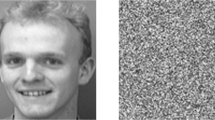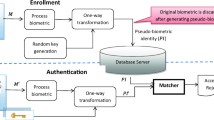Abstract
Although biometrics is being increasingly used across the world, it also raises concerns over privacy and security of the enrolled identities. This is due to the fact that biometrics are not cancelable and if compromised may give access to the intruder. To address these problems, in this paper, we suggest two simple and powerful techniques called (i) Random Permutation Principal Component Analysis (RP-PCA) and (ii) Random Permutation Two Dimensional Principal Component Analysis (RP-2DPCA). The proposed techniques are based on the idea of cancelable biometric which can be reissued if compromised. The proposed techniques work in a cryptic manner by accepting the cancelable biometric template and a key (called PIN) issued to a user. The identity of a person is recognized only if the combination of template and PIN is valid, otherwise the identity is rejected. The superiority of the proposed techniques is demonstrated on three freely available face (ORL), iris (UBIRIS) and ear (IITD) datasets against state-of-the-art methods. The key advantages of the proposed techniques are (i) classification accuracy remains unaffected due to cancelable biometric templates generated using random permutation (ii) robustness across different biometrics. In addition, no image registration is required for performing recognition.









Similar content being viewed by others
References
Prabhakar S, Pankanti S, Jain AK (2003) Biometric recognition: Security and privacy concerns. IEEE Secur Privacy Mag 1(2):33–42
Jain AK, Ross A, Prabhakar S (2004) An introduction to biometric recognition. IEEE Trans Circuits Syst Video Technol 14(1):4–20
Zhao W, Chellappa R, Phillips PJ, Rosenfeld A (2003) Face recognition: a literature survey. ACM Comput Surv 35(4):399–458
Douxchamps D, Campbell N (2007) Robust real time face tracking for the analysis of human behaviour. In: Proceedings of the 4th International Conference on Machine Learning for Multimodal Interaction, Berlin, Heidelberg, pp 1–10
Peralta D, Galar M, Triguero I, Paternain D, García S, Barrenechea E, Benítez JM, Bustince H, Herrera F (2015) A survey on fingerprint minutiae-based local matching for verification and identification: Taxonomy and experimental evaluation. Inf Sci 315(10):67–87
Marsico MD, Petrosino A, Ricciardi S (2016) Iris recognition through machine learning techniques: a survey, Pattern Recognition Letters, Available online
Gong Y (1995) Speech recognition in noisy environments: a survey. Speech Comm 16(3):261–291
Bellman RE (1961) Adaptive control processes. Princeton University Press, Princeton
Cunningham JP, Ghahramani Z (2015) Linear dimensionality reduction: survey, insights, and generalizations. J Mach Learn Res 16:2859–2900
Pearson K (1901) On lines and planes of closest fit to systems of points in space. Phil Mag 2:559–572
Hotelling H (1936) Relations between two sets of variates. Biometrika 28:321–377
Fisher RA (1936) The use of multiple measurements in taxonomic problems. Ann Eugenics 7(2):179–188
Cox TF, Cox MA (2001) Multidimensional scaling. CRC Press, Boca Raton
Wiskott L, Sejnowski T (2002) Slow feature analysis: unsupervised learning of invariances. Neural Comput 14(4):715–770
Wiskott L (2003) Slow feature analysis: a theoretical analysis of optimal free responses. Neural Comput 15 (9):2147–2177
He X, Niyogi P (2004) Locality preserving projections. In: Advances in Neural Information Processing Systems, p 16
Turk M, Pentland A (1991) Eigenfaces for recognition. J Cogn Neurosci 3(1):71–86
Sayed A, Sardeshmukh M, Limkar S (2014) Improved iris recognition using Eigen values for feature extraction for off gaze images, ICT and critical infrastructure. In: Proceedings of the 48th Annual Convention of Computer Society of India- Vol II: Hosted by CSI Vishakapatnam Chapter, pp 181–189
Yongxu W, Xinyu A, Yuanfeng D, Li Yongping (2006) A fingerprint recognition algorithm based on principal component analysis, TENCON 2006 - 2006 IEEE region 10 conference, Hong Kong
Jing X, Ma J, Zhao J, Yang H (2014) Speaker recognition based on principal component analysis of LPCC and MFCC, signal Processing. In: 2014 IEEE International Conference on Communications and Computing (ICSPCC), Guilin, pp 403–408
Yang J, Zhang D, Frangi AF, Yang J (2004) Two-dimensional PCA: a new approach to appearance-based face representation and recognition. IEEE Trans Pattern Anal Mach Intell 26(1):131–137
Patel VM, Ratha NK, Chellappa R (2015) Cancelable Biometrics: a review. IEEE Signal Process Mag 32(5):54–65
Ratha NK, Connel JH, Bolle R (2001) Enhancing security and privacy in biometrics- based authentication systems. IBM Syst J 40(3):614–634
Ratha N, Chikkerur S, Connell J, Bolle R (2007) Generating cancelable fingerprint templates. IEEE Trans Pattern Anal Mach Intell 29(4):561–572
Bolle RM, Connel JH, Ratha NK (2002) Biometrics perils and patches. Pattern Recogn 35(12):2727–2738
Pillai JK, Patel VM, Chellappa R, Ratha NK (2011) Secure and robust iris recognition using random projections and sparse representations. IEEE Trans Pattern Anal Mach Intell 30(9):1877–1893
Savvides M, Kumar B, Khosla P (2004) Cancelable biometric filters for face recognition. Proc Int Conf Pattern Recognition 3:922–925
Maiorana E, Campisi P, Fierrez J, Ortega-Garcia J, Neri A (2010) Cancelable templates for sequence-based biometrics with application to on-line signature recognition. IEEE Trans Syst., Man Cybern A 40 (3):525–538
Rathgeb C, Breitinger F, Busch C, Baier H (2014) On the application of bloom filters to iris biometrics. IET J Biometrics 3(4):207–218
Xu W, He Q, Li Y, Li T (2008) Cancelable voiceprint templates based on knowledge signatures. In: Proceedings of International Symposium Electronic Commerce and Security, pp 412–415
Teoh A, Goh A, Ngo D (2006) Random multispace quantization as an analytic mechanism for biohashing of biometric and random identity inputs. IEEE Trans Pattern Anal Mach Intell 28(12):1892–1901
Zuo J, Ratha N, Connell J (2008) Cancelable iris biometric. In: Proceedings of the International Conference on Pattern Recognition, pp 1–4
Hammerle-Uhl J, Pschernig E, Uhl A, Samarati P, Yung M, Martinelli F, Ardagna CA (2009) Cancelable iris biometrics using block re-mapping and image warping. In: Proceedings of the 12th International Conference on Information Security, Pisa, Italy, pp 135–142
Belhumeur PN, Hespanha JP, Kriegman DJ (1997) Eigenfaces vs. Fisherfaces: recognition using class specific linear projection. IEEE Trans Pattern Anal Mach Intell 19(7):711–720
Kumar N, Jaiswal A, Agrawal RK (2012) Performance evaluation of subspace methods to tackle small sample size problem in face recognition. In: Proceedings of the International Conference on Advances in Computing, Communications and Informatics (ICACCI ’12). ACM, New York, pp 938–944
Tan X, Chen S, Zhou ZH, Zhang F (2006) Face recognition from a single image per person: a survey. Pattern Recogn 39(9):1725–1745
Samaria F, Harter A (1994) Parameterisation of a stochastic model for human face identification. In: Proceedings of 2nd IEEE Workshop on Applications of Computer Vision, Sarasota FL
Proença H, Alexandre LA (2005) UBIRIS: a noisy iris image database. In: 13th International Conference on Image Analysis and Processing - ICIAP 2005, Springer, vol. LNCS 3617, pp 970–977
Kumar A, Wu C (2012) Automated human identification using ear imaging. Pattern Recogn 41(5):956–968
Author information
Authors and Affiliations
Corresponding author
Rights and permissions
About this article
Cite this article
Kumar, N., Singh, S. & Kumar, A. Random permutation principal component analysis for cancelable biometric recognition. Appl Intell 48, 2824–2836 (2018). https://doi.org/10.1007/s10489-017-1117-7
Published:
Issue Date:
DOI: https://doi.org/10.1007/s10489-017-1117-7




